Podcast: Play in new window | Download
Note: After reading this, if you’d like to learn exactly how to service a shock strut with fluid and nitrogen, check out this video training course:
Click here to check out the step-by-step video training course.
February 5, 2016
Servicing landing gear shock struts… can you do it as an airplane owner?
Absolutely! Just take a look at the list of items in Part 43, Appendix A.
However, MAKE SURE you are familiar with the procedure before you launch into on your own.
Why? Because servicing landing gear shock struts can be both messy and dangerous, if not done properly.
(Both Bogert Aviation and Aircraft Spruce have some cool strut servicing equipment, but it can be a little pricey.)
If you want to learn more about an airplane strut, you can go to this link and read an excellent article by Mike Busch, with Savvy Aviator. I find his articles to be very educational and helpful.
http://www.avweb.com/news/savvyaviator/192153-1.html

This is a strut that I serviced the other day on a Piper Cherokee.
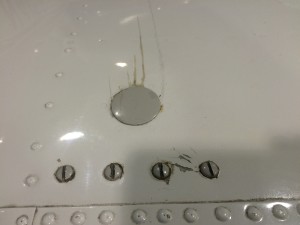
Notice the seepage on top of the wing, coming from the plug that covers the Schrader valve for servicing the shock strut.

There was a puddle of hydraulic fluid around the Schrader valve.
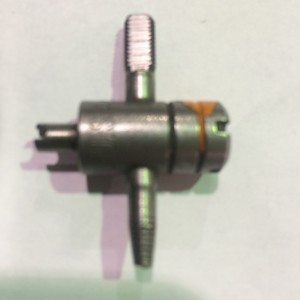
This is a simple tool for removing and tightening the valve core in the Schrader valve. Before adding air or nitrogen to a strut that is low, it’s a good idea to verify the core is tight. (You can buy this tool at an auto parts store, or even Walmart,)
In the case of the above strut, I found the Schrader valve itself needed a little tightening (with a wratchet and 3/4 inch socket.)
Listen to the audio to hear the rest of this story.
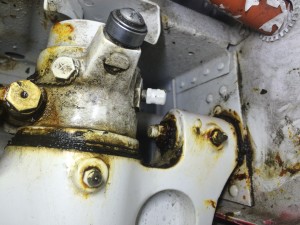
Here is a typical nosestrut on a Beech Bonanza. Notice the Schrader valve (servicing valve) with the white cap in the center of the picture. This is where fluid and nitrogen are added to the strut.
In today’s episode we’ll answer these questions:
- What type of landing gear do you have on your airplane?
- If you have an oleo (air-oil) strut, how do you know if it needs servicing?
- Does your strut need air/nitrogen, or oil (aviation hydraulic fluid,) or both?
- When does your strut need more maintenance than just “servicing?”
- What tools and equipment will be needed?
- What is the procedure for “servicing” a shock strut?
- What are some cautions to be aware of?
- What can happen if you ignore the condition of your shock struts?
So, after listening to today’s episode, I would encourage you to do the following if you have an airplane with one or more shock struts:
- Take a look in your POH or Owners Manual, and find the recommended inflation setting for your shock struts (typically in inches of extension, but can also be in psi with no load on the strut. This information will typically be in the chapter on servicing.
- Measure the extension levels on your struts and see if they meet the specs. While you do this, dampen a cloth with a little avgas, and clean the chrome shaft on the shock strut. This will help prevent any dirt or other debris from getting in the sealing area as the shaft moves up and down inside the strut housing.
- If your strut needs servicing, get some help the first time from someone with experience, and go for it!
- Make it a part of your preflight inspection, to verify your struts are at the proper level, have no fluid leakage, and that the strut shaft is clean.
One final tip for enjoying this podcast, or any podcast for that matter! (You’ll have to listen to find out what this is!)
And please… if you enjoy this podcast and want it to continue, let a few of your aviation friends know about it, and rate the podcast in iTunes. (You can also find it in Stitcher, if you prefer that.)
Also, PLEASE leave a comment below and let me know any future topics you would like to hear about. Or, you can send me an email at deanshow@gmail.com
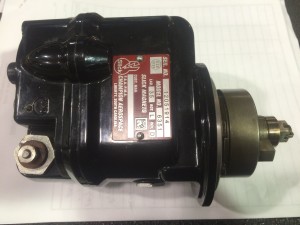
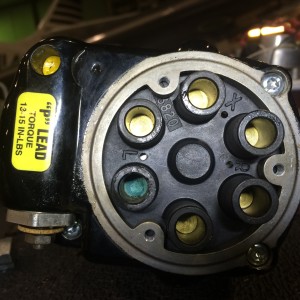
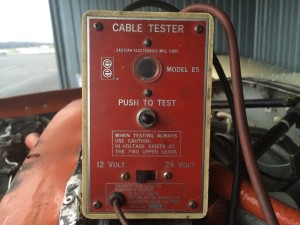

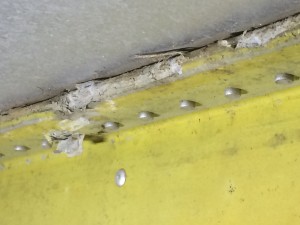







Recent Comments